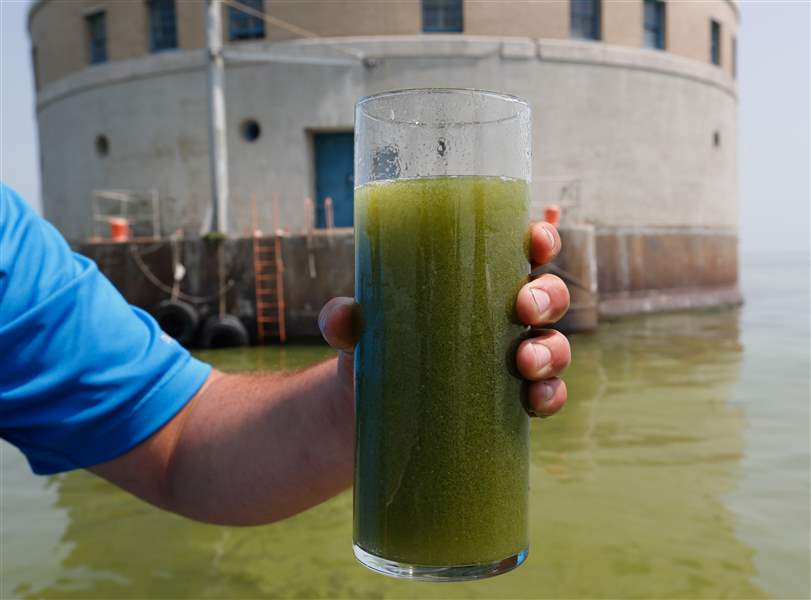
Town hall marks 3rd anniversary of Toledo's water crisis
8/2/2017
Shane Gaghen of Oregon holds a glass of algae filled Lake Erie water, near the Toledo water intake crib, August of 2014.
The Blade
Buy This Image
Environmental groups across the Great Lakes basin used the third anniversary of Toledo’s high-profile water crisis Wednesday to lobby for better management of livestock manure and commercial fertilizers applied to farmland.
The crisis began with a 2 a.m. Facebook posting by the city of Toledo. The post said city water had been poisoned by the algal toxin called microcystin. An hour later nearly all bottled water at 24-hour supermarkets within an hour’s drive of the city was gone. The majority of the metro region’s 500,000 people who awoke later that morning either drove farther distances to get water or received it from other sources, including the Ohio National Guard.
RELATED: Lake Erie algal bloom likely to be 1 of largest
The warning stayed into effect until the all-clear was given the morning of Aug. 4, 2014, with homes and businesses advised to take turns flushing out their lines for several minutes.
Still, the Toledo-Lucas County Health Department learned five weeks later a majority of people still were drinking bottled water because they didn’t trust what was coming out of their tap.
A town hall Wednesday at Toledo-Lucas County Main Library, hosted by the Buckeye State’s largest environmental group, the Ohio Environmental Council, focused on lessons learned from what happened in Toledo. About 70 people attended.
Dr. David Grossman, the retired Toledo-Lucas County health commissioner, who worked with state and federal officials to determine when water was safe to drink again in 2014, said he was “impressed by how everyone came together” three years ago. That Toledo event and the ongoing Flint water crisis have been a wake-up call about tap water, he said.
Dr. Grossman said his faith has been restored in Toledo’s water quality. On Friday morning the city is to give reporters an update on $500 million worth of improvements under way through 2020 at its Collins Park Water Treatment Plant.
Alison Avendt, ProMedica Toledo Hospital vice president of operations, said the 2014 crisis forced ProMedica to make impromptu changes at the time, such as sending operation instruments to medical facilities outside of the metro area because of fears of cleaning them with Toledo water.
Kristy Meyer, Ohio Environmental Council policy vice president, said during an afternoon webinar that many Ohio farmers are “doing great things.”
“What we need is a much broader scale of these [water-conservation] practices being implemented,” Ms. Meyer said.
She was joined on the webinar by members of the Chicago-based Alliance for the Great Lakes, the Michigan League of Conservation Voters, and Freshwater Future, a group based in Petoskey, Mich.
Toledo-based Advocates for a Clean Lake Erie called upon Toledo mayoral and council candidates to support the group’s campaign for designating the open water of western Lake Erie as impaired, a move that could result in stricter U.S. Environmental Protection Agency oversight of farm runoff and other sources of algae-growing nutrients.
The Kasich administration has resisted such efforts, stating it believes the Ohio Farm Bureau Federation and other agricultural groups are making strides in reducing agricultural runoff through voluntary incentives.
Contact Tom Henry at thenry@theblade.com, 419-724-6079 or via Twitter @ecowriterohio.